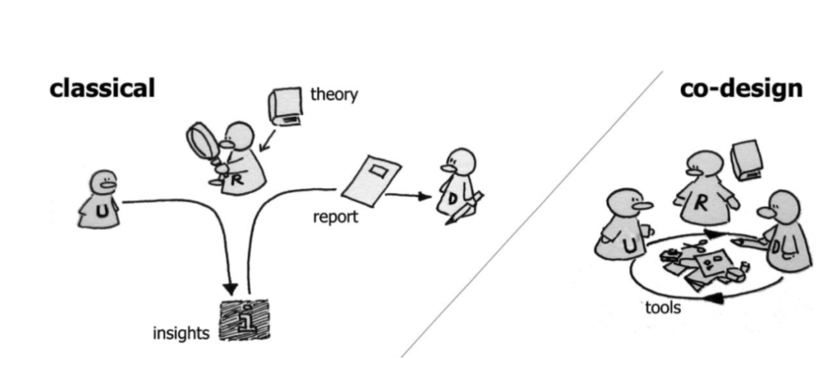Recently, participatory design was used to great success on a project. Our clients asked us if we could talk more about it, share its function with other teams and explore ways of potentially applying it in the future.
What is participatory design?
Participatory design is a research method that encourages collaboration and mixing the roles of researcher, designer, and user to elicit collective creativity in the design development process (Sanders and Stappers, 2008). Participatory design started in Scandinavia in the late 1960s – early 1970s aiming to involve workers in shaping the future of their work through a more democratic process (Nygaard, 1990; Preece et al., 2015). It is used most frequently in the planning and discovery phase of a research cycle.
‘Participatory Design is a set of theories, practices, and studies related to end-users as full participants in activities leading to software and hardware computer products and computer-based activities’
Muller & Druin, 2012: 3
How to conduct participatory design?
Participatory design can be implemented either in the simple format of a workshop or as a research approach that involves the heavy inclusion of users and stakeholders. It can be shaped as a combination of collaborative exercises at the end of a contextual inquiry, as a one-day workshop or anytime the designers and researchers of a delivery team get the chance to produce ideas and designs in collaboration with the users. In a workshop, users are given augmented agency through a creative process.
The image below illustrates the difference between designing by focusing on the product/ service/ technology and designing by focusing on people’s actual needs. In participatory design or co-design, the user, for whom the service/ product is under development, is the ‘expert of their experience and contributes with increased agency to knowledge development, idea generation and concept development’ (Sanders and Stappers, 2008: 12). The researcher and designer provide the tools for expression and ideation of needs and desires.

In the classical representation, the user represents the object of study, the researcher observes the user and acquires knowledge and the designer reports on the process and builds a comprehension of the technology and the necessary next steps in creative thinking. In co-design, the roles are mixed and interchangeable between user, researcher and designer. (Sanders and Stappers, 2008).
At Methods, we followed a participatory approach during the Alpha phase of a Department for Education (DfE) project, collaborating closely with internal users (Education, Skills and Funding Agency employees) throughout the whole project. Being agile is at the core of our organisation and during this project, our team worked very closely with the internal team to establish validity and understanding of the current use and needs of a new service. We also conducted a workshop to understand the needs, information prioritisation, user journey and challenges of external users (education providers) with regards to a specific funding stream.
4 outcomes of implementing participatory design in our DfE project
- A deeper understanding of and connection with external users by giving them the appropriate tools to express themselves and suggest solutions to improve a particular funding stream.
- Increased feelings of trust. After spending time with users, being transparent with them and including them in the design process, research participants reported they felt valued and glad their voices were heard.
- Enabled internal users to gain insight into the research process and to witness the outcome of their efforts by inviting them along to User Research sessions. This allowed for a deeper understanding of the external user needs and challenges. Internal users contributed a lot to our work with their experience and knowledge.
- Positive feedback after sharing the methodology, findings, and benefits with broader teams of DfE, leading to future projects.
Participatory design empowers people by giving them greater control in shaping the future of the services they use. It enables creativity, boosts morale and feelings of empowerment through collaboration between the owner and the beneficiary of a service.
Please feel free to get in touch if you are interested in learning more about this or if you have any thoughts or comments: tatiana.styliari@methods.co.uk.
References
- Muller, M., Wildman, D. and White, E. (1993) Taxonomy Of PD Practices: A Brief Practitioner’s Guide in Comminications of the ACM, vol. 36, No 4.
- Muller, M. & Druin, A. (2012) Participatory Design: The Third Space in HCI. Handbook of HCI.
- Nygaard, K. (1990) The origins of the Scandinavian school, why and how? Participatory Design Conference 1990
- Preece, J., Rogers, Y., & Sharp, H. (2015) Interaction design: Beyond human-computer interaction (4th ed). Chichester: Wiley.
- Sanders, E. B.-N. and Stappers, P. J. (2008) Co-creation and the new landscapes of Co-Design, 4:1, 5-18, DOI: 10.1080/15710880701875068.
- Spinuzzi, C. (2005) The methodology of participatory design. Technical Communication, 52(2), 163–174.